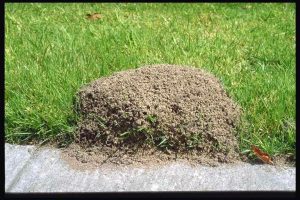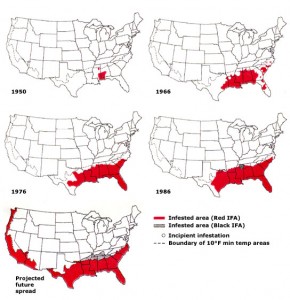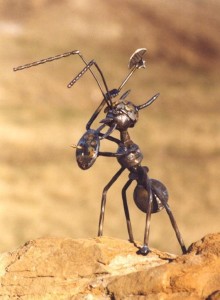At least 38 counties in Oklahoma have been infested with Imported Fire Ants; 20 of those are under federal quarantine to try and stop the spread. The map below doesn’t even show them in Oklahoma yet but does give you an idea of how fast and far they’ve gone.
“We’re never going to completely eradicate the fire ant, but we can slow the spread,” said Jeanetta Cooper, the agricultural services administrator for the state Agriculture, Food and Forestry Department.
Fire ants were first introduced to America in 1918 to a ship port in Alabama. (Some say Georgia) They have since spread to every southern state and now are making their march northward. There are some 280 different species and they can be found mostly in Taiwan, Australia, China and the Philippines.
The Fire Ant is an invasive species that tends to drive ‘competition’ out as they lay claim to your yard or the fields they inhabit. 5 billion dollars is spent in the U.S. alone for medical treatment, control efforts and damage due to this tiny creature. New products come out almost annually but nothing seems to keep up with their spread.
Fire ants build characteristic mounds that either tower up to 2 feet high or spread along the ground with many entry holes visible depending on the species. The queen’s chambers may be 2 to 3 feet below the surface making total elimination difficult. She lays up to 1500 eggs per day and many kinds of Fire ants have multiple queens. You may need a calculator to do that math.
3 feet below the surface making total elimination difficult. She lays up to 1500 eggs per day and many kinds of Fire ants have multiple queens. You may need a calculator to do that math.
Baits can work particularly well such as Amdro or Maxforce. They readily take the food down to the ‘processing’ area where the larvae chew up the solid bait and turn it into a liquid (adult ants can’t eat solid food) which they excrete and the adults can eat.  The queen however is fed later in this process as a security measure. If the bait acts to quickly and 1000’s begin to die off, she won’t eat and she lives to replenishes the colony. This in this case may only take a few days.
The queen however is fed later in this process as a security measure. If the bait acts to quickly and 1000’s begin to die off, she won’t eat and she lives to replenishes the colony. This in this case may only take a few days.
To many homeowners store there unused baits in sheds or garages where it gets real hot. This heat will cook the bait and ruin the palatability of the bait and may just create a chemical breakdown so it’s no good even if they do eat it. I always recommend baiting in the cooler evening hours when more ants are out and the sun is not so hot for best results.
Drenching mounds make be satisfying for the moment, seeing hundreds of dying ants at your mercy but unless you have a treating rod to inject deep in the soil or use a WHOLE bunch of pesticide you may only get most of the ants but not all. Granules are not so effective because of its slower mode of action and the ants will simply move to an untreated spot. Some granule products are made to create a dead zone layer across your entire yard and this can last up to a year but the price of a 50 lb. bag is pretty steep and it takes at least 30 days to kick in.
bunch of pesticide you may only get most of the ants but not all. Granules are not so effective because of its slower mode of action and the ants will simply move to an untreated spot. Some granule products are made to create a dead zone layer across your entire yard and this can last up to a year but the price of a 50 lb. bag is pretty steep and it takes at least 30 days to kick in.
All in all Fire ants are a serious problem that is spreading out across the country. When they adapt to the cold and the snow then you folks in Minnesota might be known for more than just your lakes and an indoor football team.




